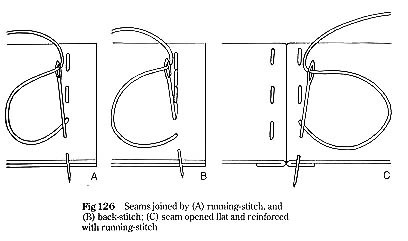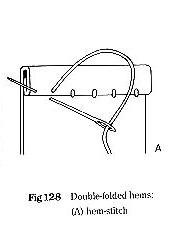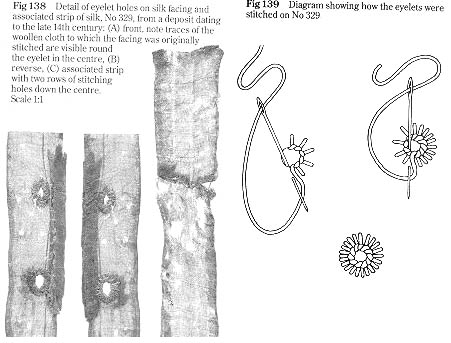 |
 |
|
|
From T&C p 158:
Note that they are not stating that bias-cuts were not used, but that they were not known to have been used for bias facings & bindings. |
 |
|
Sherts, Trewes, & Hose .ij. :
Documentable Details
| by maistre Emrys Eustace, hight Broom | |
| IAmBroom @ yahoo . com |
As the title indicates, this article is focused on the details that we can document.
Sewing Overview
 |
 |
|
|
From T&C p 158:
Note that they are not stating that bias-cuts were not used, but that they were not known to have been used for bias facings & bindings. |
 |
|
Regarding rolled hems (same page):
"The technique is used solely on the fine transparent silk veils of the late 14th-century… where it has proved most efficient as well as unobtrusive."
A decorative and sturdy edge treatment commonly used was to tablet weave the end threads.
|
Tablet-woven edge treatment, T&C p 161 |
Estimated Times to Manufacture Clothes Based on prices in 14th c. From T&C p151.
12d. (pennies) = 1s. (schilling), 20s. = 1£ (pound) |
Buttons & Buttonholes
|
|
||
|
Buttonhole stitch, T&C |
Buttonholes, T&C p 170 | Buttons, T&C p 169 |
|
Braided cords Probably every young medieval girl learned at least a couple of different ways to fingerbraid. From simple yarn a cord as strong as desired can thus be made cheaply. T&C [138-42] documents fingerloops with from 5 to 20 loops each, as well as plaited braids (unlooped ends), and tabby-woven (plain weave) ribbons. Any of these could be used as a cinch cord, lace, or hose point. All of the T&C London finds were of silk (the strongest medieval fiber), and all but one were monochrome. Neckline Facing
|
Cloth Buttons |
Garters and Dags
|
|
|
|
|
|
Eyelets
Fig 87 of Janet Arnold's Patterns of Fashion is a photograph of eyelets used in breeches from 1574 Florence. These eyelets have a thin metal ring that is oversewn (or "buttonstitched") to reinforce the holes. Bodices of this period were reinforced in similar ways, to take the stress of tight-lacing.
This page also shows sets of hook & eyes in two other garments. Page 24 also has examples of hook and eyes, sewn eyes, and buttonholes. Fig. 151 states that hooks and eyes were still new and that they would soon displace and replace the use of points in clothing, at the end of our period, c1605-1610.

Eyelet construction & examples, p 164
Bibliography
Arnold, Janet. Patterns of Fashion - The Cut and Construction of Clothes for Men and Women c 1560-1620.
Boucher, François. 20,000 Years of Fashion. The History of Costume and Personal Adornment (Expanded Edition). (Harry N. Abrams, Inc., NY 1983). ISBN 0-8109-1693-2.
Crowfoot, Elisabeth; Frances Pritchard, and Kay Staniland. Textiles and Clothing, c.1150-c.1450. (Medieval Finds from Excavations in London: 4) (alias "T&C") (London: HMSO, 1992).
Webliography
Fingerbraiding sites:
Andy Goddard. http://www.bumply.com/Medieval/finger.htm
"Phiala" (SCA name; no contact information
provided):
http://www.duke.edu/~scg3/braids.html,
http://www.duke.edu/~scg3/fingerloop.html
Priest-Dorman, Carolyn (Þóra Sharptooth). (copyright
1997-2000 )
http://www.cs.vassar.edu/~capriest/fingerloop.html